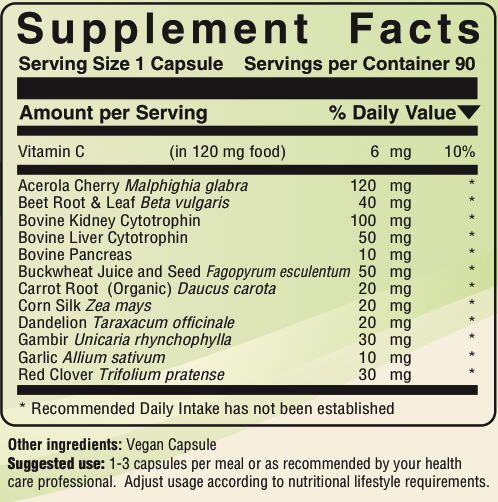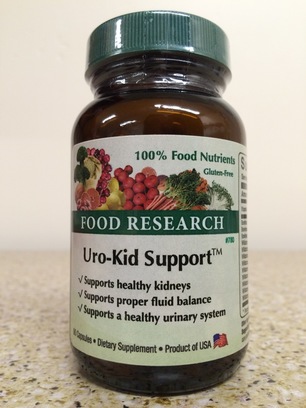
Uro-Kid Support TM
90 Capsules $24.98
90 Capsules $24.98
“The urinary tract is that part of the body involved in the formation, concentration, and excretion (clearing) of urine. The urinary tract system includes kidneys, which make urine out of the blood…, the ureters, which are tubes taking urine from the kidneys to the bladder, and the urethras, which are tubes taking urine from the bladder out of the body” [1]. “The kidneys are the primary means for eliminating waste products of metabolism that are no longer needed by the body. These products include urea…creatinine…uric acid…end products of hemoglobin breakdown…and metabolites of various hormones…The kidneys also eliminate most other toxins and other foreign substances…such as pesticides, drugs, and food additives” [2].
The kidneys can also be a factor in primary, as well as secondary, hypertension. Also, “Renovascular hypertension should be suspected when diastolic hypertension first develops in patients < 30 or > 55 or when previously stable hypertension abruptly accelerates” [3 ].
Acerola cherry , Malphighia glabra ,is one of the most vitamin C dense Foods. Vitamin C is advised for urinary infections [1]. “Malphighia glabra has also been shown active anti-fungal properties” [4]. Arginase, a critical enzyme needed to produce urea [5], is activated by vitamin C [6]. Vitamin C also acidifies the urine, making it helpful for urinary tract infections [7].
Beet leaf and root have been used by herbalists for centuries [8] .“Beet is said to have antihepatoxic effects” [9]. “Beets and beet juice have also been used to eradicate gallstones, kidney stones, bladder disorders, and kidney disease” [8]. A study using a beet leaf-like plant “ concluded that the extract of this plant may reduce serum urea and creatinine levels and confer a protective effect on the kidney of diabetic rats ” [10].
Bovine kidney supplies kidney tissue. Kidney tissue naturally contains kidney enzymes, proteins, and other peptides needed for proper renal function. “The kidneys perform their most important functions by filtering the plasma and removing substances from the filtrate at a variable rate, depending upon the needs of the body. Ultimately, the kidneys ‘clear’ unwanted substances from the filtrate (and therefore from the blood) by excreting them in the urine while returning substances that are needed back to the blood…Urine formation begins with filtration of large amounts of fluid through the glomerular capillaries into Bowman’s capsule…The kidney conserves water by excreting a concentrated urine” [2]. Helping concentrate urine also reduces the possibility of urinary tract infections, and reduces extra trips to the restroom. Kidney tissue is recommended for urinary tract infections and to strengthen the kidneys [7]. The kidney tissue found in Uro-Kid Support is from New Zealand.
Bovine liver supplies liver tissue. Bovine liver tissue contains the substances naturally found in the liver, like arginase [5]. In order to convert the high arginine intermediate substrate into urea and orthinine, the body uses the enzyme arginase. “The liver has the greatest amount of this enzyme, and accounts for the majority of urea synthesis…[a] small amount is carried out by the kidney and brain…the hydrolysis of arginine to urea and orthinine makes possible the urea cycle” [5]. An excess accumulation of arginine (due to insufficient arginase) contributes to excessively frequent urination (as the body tries to flush this diluted semi-urine out) and increases in urinary tract infections (as this less concentrated semi-urine is a less hostile environment for pathogens than concentrated urine is). “The liver is well known for its ability to detoxify or excrete…many drugs…hormones” and other substances” [2]. The liver tissue found in Uro-Kid Support is from New Zealand.
Buckwheat juice and seed has long been used as part of nutrition to support the intermediate processes involving urea metabolism and “support liver and kidney function where toxic overload places stress on these organs” [11]. “A 20% drop in systolic level is not unusual in the initial stages, progressively lowering under long term use. Importance of protracted treatment should be stressed” [12]. Though most often recommended for capillary and venous health (i.e. bruising, varicose veins) [9,12], naturopaths, chiropractors, and holistic doctors have long recommended its leaves or its immune supporting components in products to fight viral and bacterial infections [7,13,14]. In addition to containing chlorophyll, presumably active components include rutin, quercitin, and hyperoside [9] (it also contains other semi-unique Food substances that may be actively needed). It should be noted that, despite its name, buckwheat is not taxonomically related to wheat, and is often used in gluten-free, wheat-free diets [15].
Carrots have long been used in combination with beet leaf to help in conditions of “liver and gallbladder stasis [16]. Carrots supply carotenoids such as betacarotene, a vitamin A precursor, which helps strengthen the immune system [4]. “Scientists in India have discovered that carrots afford significant protection for the liver” as carrots contain substances which “increase the activity of several enzymes that speed up detoxification of the liver and other organs” [17]. A study involving diabetics found “ that the antioxidative activity of astaxanthin reduced the oxidative stress on the kidneys and prevented renal cell damage ” [18]. Astaxanthin is a carotenoid.
Corn silk has long been used by herbalists for urinary [9] and kidney concerns, including bedwetting [7].
Dandelion “has a diuretic effect and is used for kidney and bladder complaints and kidney stone formation” [9]. It is approved by the German Commission E for infections of the urinary tract, liver complaints, and gall bladder complaints [9]. “Dandelions are one of nature’s richest green vegetable source of beta-carotene, from which vitamin A is created” [19]. “It is effective as a detoxifying herb” [19].
Gambir exhibits antibacterial and algicidal efficiacy [9]. Gambir has been found to be effective against e-coli [20]. “Uncaria rhynchophylla is a medicinal herb used for convulsive disorders in Oriental medicine” [21]. It exerts hypotensive and vasodilatory effects [22] and is also sometimes used in products for those with hypertension.
Garlic “[d]etoxifies the body and protects against infection by enhancing immune function. Lowers blood pressure and improves circulation. Lowers blood lipid levels’ [7]. “Garlic kills bacteria…Garlic is the ideal natural medicine for resolving high blood pressure” [8]. Garlic has antihypertensive effects [9].
Ovine pancreas supplies a variety of pancreatic enzymes. Most pancreatic enzymes are involved in digestion, which is needed for proper elimination [2]. The pancreatic tissue found in Uro-Kid Support is from New Zealand.
Red Clover “[a]cts as an antibiotic, appetite suppressant, blood purifier, and relaxant. Good for bacterial infections…liver disease, skin disorders, and weakened immune system” [7]. Red clover has antispasmodic effects [9]. It may have preventative properties related systolic hypertension [23]. It is advised for bladder problems, kidney problems, and urinary problems [24].
Many people simply take Uro-Kid as a Food supplement to help them feel better.

Unlike many so-called “natural” formulas, Uro-Kid Support is only comprised of foods, contains no synthetic USP nutrients or isolated mineral salts, but only contains foods, food complexes, and food concentrates.
Numerous university studies have concluded that supplements containing food nutrients are better than USP isolates. Food nutrients are better because they contain important enzymes, peptides, and phytonutrients CRITICAL to the UTILIZATION of vitamins and minerals which are not present in isolated USP nutrients. Published research has concluded that food vitamins are superior synthetic/USP vitamins.
Suggested use: 1-3 capsules per meal or as recommended by your health care professional. Adjust usage according to nutritional lifestyle requirements.
References
[1] Strohecker J, ed. Alternative Medicine, The Definitive Guide. Future Medicine Publishing, Fife (WA), 1995
[2 ] Guyton AG, Hall JE. Textbook of Medical Physiology, 9th ed. W.B. Saunders Co., Phil., 1996
[3] Beers MH and Berkow R, eds. The Merck Manual of Diagnosis and Therapy, 17 th ed. Merck Research Laboratories, Whitehouse Station (NJ), 1999
[4] Sheldon S, Rorvik D, eds. PDR for Nutritional Supplements. Medical Economics, Montvale (NJ), 2001
[5] Bondy PK, Rosenberg LE. Duncan’s Diseases of Metabolism, 7 th ed. WB Saunder, Phil, 1974
[6] Ruskin SL. High dosage vitamin C in allergy. Am J Dig Dis, 1995;12(9):281-313
[7] Balch JF, Balch PA. Prescription for a Nutritional Healing, 2 nd ed. Avery Publishing, Garden City Park (NJ), 1997
[8] Ingram C. Super-Market Remedies. Knowledge House, Buffalo Grove (IL), 1998
[9] Gruenwald J, Brendler T, Jaenicke C, eds. PDR for Herbal Medicine, 3rd ed. Thompson PDR, Montvale (NJ), 2004
[10] Yanardag R, Bolkent S, Ozsoy-Sacan O, Karabulut-Bulan O. The effects of chard (Beta vulgaris L. var. cicla) extract on the kidney tissue, serum urea and creatinine levels of diabetic rats. Phytother Res. 2002;16(8):758-61
[11] Lee R. Arginex. In Product Bulletins, circa 1950
[12] Lee R. Cyruta. In Product Bulletins, circa 1950
[13] Thiel R. Serious Nutrition for Health Care Professionals, 2n ed. Center for Natural Health Research, Arroyo Grande (CA), 1996
[14] Versendaal DA. Contract Reflex Assessment and Applied Trophology. Dr. D.A. Versendaal, Holland (MI), 1990
[15] Hafstrom I, Ringertz B, Spangberg A, et al, A Vegan Diet Free of Gluten Improves the Signs and Symptoms of Rheumatoid Arthritis: The Effects on Arthritis Correlate With a Reduction in Antibodies to Food Antigens. Rheumatology, 2001;40:1175-1179
[16] Lee R. Vitamins A & F With Betafood. In Product Bulletins, circa 1950
[17] Duke JA. The Green Pharmacy. Rodale Press, Emmaus (PA), 1997
[18] Naito Y, Uchiyama K, Aoi W, Hasegawa G, Nakamura N, Yoshida N, Maoka T, Takahashi J, Yoshikawa T. Prevention of diabetic nephropathy by treatment with astaxanthin in diabetic db/db mice. Biofactors. 2004;20(1):49-59
[19] DerMardenosian A, ed. The Review of Natural Products. Facts and Comparisons, St. Louis, 2000
[20] Voravuthikunchai S, Lortheeranuwat A, Jeeju W, Sririrak T, Phongpaichit S, Supawita T. Effective medicinal plants against enterohaemorrhagic Escherichia coli O157:H7. J Ethnopharmacol. 2004;94(1):49-54
[21] Lee J, Son D, Lee P, Kim DK, Shin MC, Jang MH, Kim CJ, Kim YS, Kim SY, Kim H. Protective effect of methanol extract of Uncaria rhynchophylla against excitotoxicity induced by N-methyl-D-aspartate in rat hippocampus. J Pharmacol Sci. 2003;92(1):70-73
[22] Zhang WB, Chen CX, Sim SM, Kwan CY. In vitro vasodilator mechanisms of the indole alkaloids rhynchophylline and isorhynchophylline, isolated from the hook of Uncaria rhynchophylla (Miquel). Naunyn Schmiedebergs Arch Pharmacol. 2004;369(2):232-238
[23] Nestel PJ, Pomeroy S, Kay S, Komesaroff P, Behrsing J, Cameron JD, West L. Isoflavones from red clover improve systemic arterial compliance but not plasma lipids in menopausal women. J Clin Endocrinol Metab. 1999;84(3):895-898
[24] Ritchason J. The Little Herb Encyclopedia, 3 rd ed. Woodland Books, Pleasant Grove (UT), 1995
Some of these studies (or citations) may not conform to peer review standards, therefore, the results are not conclusive. Professionals can, and often do, come to different conclusions when reviewing scientific data. None of these statements have been reviewed by the FDA. All products distributed by Doctors’ Research, Inc. are nutritional and are not intended for the treatment or prevention of any medical condition.
 |
||
|
||
